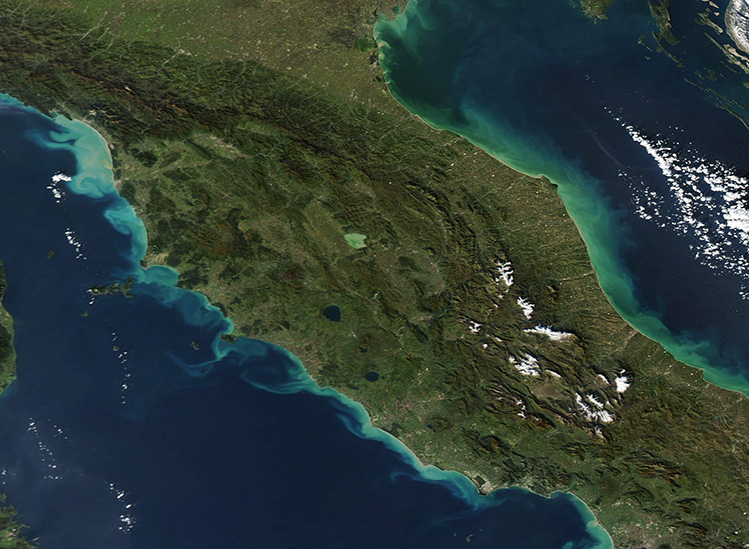Images
November 27, 2024 - Central Italy
Tweet
The sky was clear and bright over Central Italy on November 23, 2024, allowing the Moderate Resolution Imaging Spectroradiometer (MODIS) on NASA’s Aqua satellite to acquire this true-color image of the region.
Swirls of tan sediment color the waters off the coasts of the long Italian Peninsula, both in the Mediterranean Sea, in the northeast and the Tyrrhenian Sea to the southwest. Italy has faced stormy weather, with heavy winds, rain, and flooding, in several locations since mid-November. The foul weather undoubtedly contributed to coastal run-off of sediment into the seas.
In the south, snow caps the highest elevations of the Apennine Mountains, the long range that makes up the spine of peninsular Italy. Also notable are a series of lakes that spot the southern peninsula in Central Italy. The round lakes have formed in calderas, which are depressions that form after violent, explosive eruptions empty a volcano’s underlying magma chamber. Over time, the rims of the caldera can collapse into the caldera, while the depression fills with water. The most notable caldera lake in the image is the turquoise-tinted Lake Trasimeno, located near the center. The bright colors seen in these waters are a mix of sediment, which is easily stirred up by wind in the shallow lake, and growth of tiny single-celled organisms known as phytoplankton.
Image Facts
Satellite:
Aqua
Date Acquired: 11/23/2024
Resolutions:
1km (152.7 KB), 500m (408.2 KB), 250m (710.5 KB)
Bands Used: 1,4,3
Image Credit:
MODIS Land Rapid Response Team, NASA GSFC
Tweet
The sky was clear and bright over Central Italy on November 23, 2024, allowing the Moderate Resolution Imaging Spectroradiometer (MODIS) on NASA’s Aqua satellite to acquire this true-color image of the region.
Swirls of tan sediment color the waters off the coasts of the long Italian Peninsula, both in the Mediterranean Sea, in the northeast and the Tyrrhenian Sea to the southwest. Italy has faced stormy weather, with heavy winds, rain, and flooding, in several locations since mid-November. The foul weather undoubtedly contributed to coastal run-off of sediment into the seas.
In the south, snow caps the highest elevations of the Apennine Mountains, the long range that makes up the spine of peninsular Italy. Also notable are a series of lakes that spot the southern peninsula in Central Italy. The round lakes have formed in calderas, which are depressions that form after violent, explosive eruptions empty a volcano’s underlying magma chamber. Over time, the rims of the caldera can collapse into the caldera, while the depression fills with water. The most notable caldera lake in the image is the turquoise-tinted Lake Trasimeno, located near the center. The bright colors seen in these waters are a mix of sediment, which is easily stirred up by wind in the shallow lake, and growth of tiny single-celled organisms known as phytoplankton.
Image Facts
Satellite:
Aqua
Date Acquired: 11/23/2024
Resolutions:
1km (152.7 KB), 500m (408.2 KB), 250m (710.5 KB)
Bands Used: 1,4,3
Image Credit:
MODIS Land Rapid Response Team, NASA GSFC




